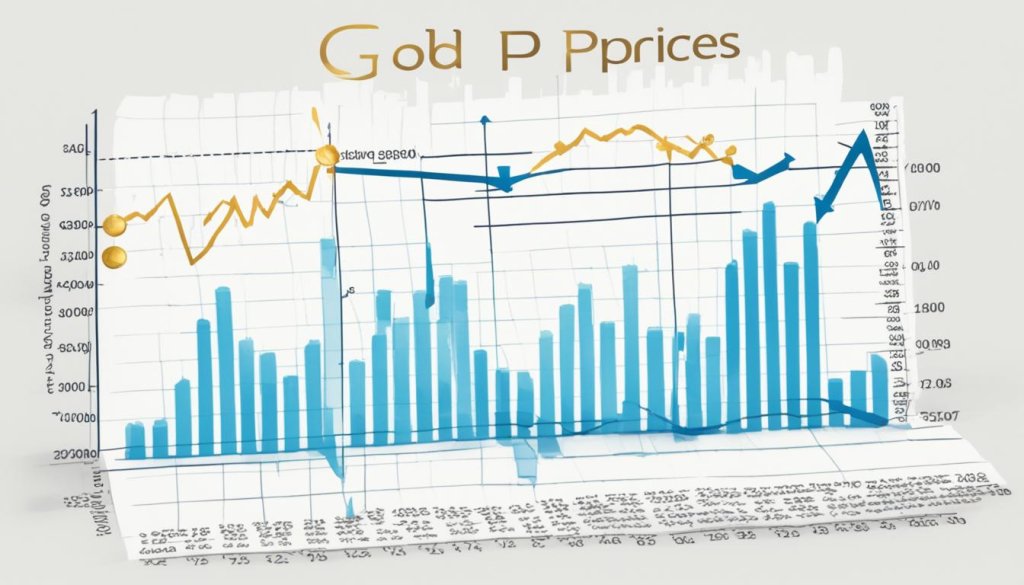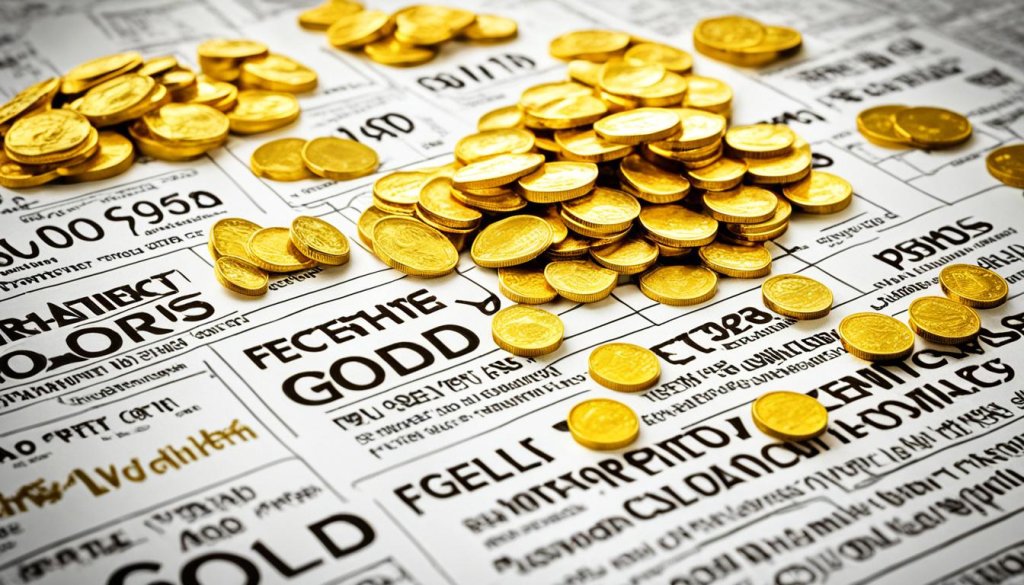Today’s Ounce Gold Price – Current Rates & Trends

The allure of gold has endured through the ages, with its shimmering hue symbolizing wealth and stability. As we navigate the modern financial landscape, the current gold rate continues to be a critical factor for savvy investors around the globe. Daily fluctuations in the spot gold price demand attention from those involved in gold trading, as these changes can sway investment decisions significantly. In this dynamic environment, an in-depth understanding of market trends becomes invaluable for those seeking to solidify their investment portfolio with this precious metal.
Today, as we explore the versatility and resilience of gold as an investment, we delve into various facets that influence its pricing. From technical analysis to global economic pointers, each element plays a pivotal role in shaping the gold market. Stay tuned for a comprehensive analysis, ensuring you remain at the forefront of informed decision-making in the fascinating world of gold investment.
Understanding Gold Spot Prices And Market Dynamics
The intricacies of gold spot prices are pivotal to the global market, reflecting the minute-to-minute consensus on the value of gold. These prices are a benchmark for dealers, investors, and institutions, informing decisions and strategies in the gold market. As we delve into the foundation of gold price determination, the roles of the London Bullion Market Association (LBMA) and the Commodity Exchange, Inc. (COMEX) are instrumental in shaping the international landscape of gold trading.
How The LBMA And COMEX Establish Gold Prices
At the heart of price determination lies the LBMA, renowned for setting the international standard for the pricing of gold. Through its electronic auctions, the LBMA commands the gold spot prices by striking a balance between supply and demand. Parallel to this, COMEX—part of the New York Mercantile Exchange—infuses the market with predictions via futures trading. This anticipation of future prices significantly influences current spot prices, sculpting the foundation of price discovery.
International Factors Affecting The Spot Price Of Gold
Global forces interplay to shape gold spot prices, where currency exchange rates and economic sentiment steer its undulations. The synchronized motions of LBMA and COMEX perpetuate a reliable and transparent platform for price determination, considering these international factors. Market participants thus retain access to invaluable real-time spot prices, ensuring their trading and investment platforms rest on informed, strategic decisions within the global market context.
Insights Into Gold Derivatives And Their Impact On Prices
Gold derivatives are complex financial instruments that have a transformative impact on the investment landscape. They allow investors the flexibility to gain exposure to gold’s price movements without holding the physical commodity. These instruments, while providing an alternative to direct investment in gold, carry their unique profiles of investment costs and risks.
Comparing Gold Futures, Options, ETFs, Swaps, And Forwards
Each type of gold derivative serves different investor needs. Gold futures offer high liquidity and the ability to leverage, whereas options give the buyer the right, but not the obligation, to purchase or sell gold at a predetermined price. ETFs provide an easy way to invest in gold while offering the added convenience of being tradable like stocks. Swaps and forwards are more complex and are often utilised by institutional investors for hedging purposes or to lock in prices for future transactions.
The True Costs Of Gold Derivatives Over Time
Despite their appeal, gold derivatives come with layers of costs that can affect the profitability of these investments. Investment costs, such as management fees, particularly with ETFs, as well as potential market illiquidity or the spread between bid and ask prices, can erode returns over time. Additionally, the complexity involved in pricing these gold derivatives means investors must have a strong grasp of the underlying market mechanisms and potential risks.
- Gold Futures: Costs include margin requirements, and investors must also navigate the rolling over of contracts to maintain a position.
- Gold ETFs: These carry annual expense ratios, potentially impacting long-term investment returns.
- Options: Premiums paid for the rights they confer are an upfront cost that could expire worthless if the market moves against the position.
- Swaps/Forwards: The costs are embedded in the terms of the contracts and may include bid-offer spreads and credit risk from counterparties.
Effective engagement with gold derivatives requires a strategic understanding of these nuanced investment costs and the implications they have on the overall profitability and risk profile of an investor’s portfolio. These financial instruments, while offering diverse avenues to participate in the gold market, demand due diligence and a sophisticated approach to harnessing their potential advantages while mitigating associated costs.
Historical Perspective: Record Gold Price Movements
As an asset that has endured the test of time, gold’s value is particularly sensitive to changes within the realms of economic uncertainty and geopolitical turmoil. The recent surge in record gold prices serves as a prime example of this sensitivity, with December 3rd, 2023, witnessing gold prices reaching a historic peak. The implications of such an event are vast and multifaceted, intricately woven into the broader tapestry of investment strategy.
Deciphering The Causes Behind Peak Gold Prices
In exploring the factors that contribute to such unprecedented heights in gold valuations, one must delve into the interplay of various market forces and policy decisions. Notably, the financial markets hang on every word of the Federal Reserve, and recent indications of possible rate cuts have exacted a formidable influence on the allure of gold as an investment.
Gold’s Response To Economic And Geopolitical Events
The COVID-19 pandemic demonstrated gold’s entrenched status as a safe haven during times of global distress. Economic downturns, alongside prolonged periods of low interest rates, have consistently bolstered investor appetite for gold. Furthermore, gold’s traditionally inverse correlation with fiat currencies offers a compelling refuge in times of currency devaluation, further reinforcing its standing amidst escalating geopolitical turmoil.

Please note, markdown formatting is not used within HTML, so no bolding or list markdown formatting was applied, as they are incompatible with the HTML standards and instructions given.
Economic Indicators And Their Influence On Gold Values
As precious metals enthusiasts and investors grapple with changing market scenarios, it’s imperative to examine how economic indicators sway the intrinsic value of gold. In the labyrinth of financial markets, metrics like inflation, interest rates, and the strength of the U.S. dollar emerge as key players in sculpting gold’s market value. Acknowledging these elements not only refines one’s understanding but molds a comprehensive strategy for gold investment.
The Inverse Relationship Between Gold Prices And The U.S. Dollar
The tango between the U.S. dollar and gold prices is a classic one, with each step in Dollar strength or weakness mirrored by a countermove in gold value. When inflation nibbles away at the Dollar’s purchasing power, investors invariably turn to gold as a reliable store of wealth, thereby hiking its price.
Central Bank Policies And Their Effects On Gold
Central banks play a pivotal role in the global gold market, often acting as gatekeepers who can significantly influence prices. Through their policies, such as adjusting reserve holdings or altering interest rates, central banks have the power to send rippling effects across the bullion landscape, affecting the valuation of gold and subsequently, investment portfolios around the globe.
Ounce Gold Price Today: Analysis Of Current Market Trends
The ever-evolving current gold prices are a testament to the dynamic nature of precious metals markets. With our finger firmly on the pulse of gold investment trends, we provide an in-depth look into the factors contributing to today’s valuation of this enduring asset. Relying on comprehensive market analysis, investors gather insights that steer their strategies through the volatile terrains of the finance world.
So, what exactly is influencing the current valuation of gold? Here are pivotal considerations:
- Real-Time Data: With live gold price updates multiple times a minute, investors are equipped to make swift, informed decisions amidst market fluctuations.
- Global Economic Conditions: From inflation to trade agreements, international economic developments exert palpable pressure on gold’s supply and demand equations.
- Currency Fluctuations: The interplay between gold and fiat currencies, like the US Dollar or the Euro, is a classic dance that affects the metal’s pricing daily.
- Investor Preferences: As risk appetites shift and alternative investment vehicles emerge, preferences fuel trends in gold’s demand – and consequently, its price.
Today’s assessment of current gold prices paints a broader picture that transcends mere numbers; it’s a narrative shaped by worldwide events, decisions by central banks, and collective investor behavior. The perpetual motion of the gold investment trends reflects a market that’s as malleable as the metal itself, yet steadfast in representing a sanctuary of value across time.
Factors That Influence Gold Prices
As a tangible asset with millennia of value recognition, gold’s allure continues to be influenced by a mix of modern financial dynamics. Understanding the ebb and flow of these influencing factors provides a crucial lens through which investors and analysts view the precious metal’s market.

The Role Of Investor Sentiment And Technical Analysis
Investor sentiment plays a pivotal role in the pricing of gold, often acting as a barometer for market trends. The psychological climate amongst investors can quickly shift gold prices, as their collective bullishness or bearishness impacts buying patterns. Alongside this, technical analysis serves as a crucial tool, assessing past market data, trends, and price movements to forecast future price trajectory. This method sees frequent application in formulating investment strategies within the gold market.
Supply And Demand: The Basic Economics Of Gold
The fundamental economics of supply and demand remain the backbone of gold valuation. On the supply side, mining companies’ ability to extract gold from the earth plays a significant role. Any disruption in mining activity can cause a ripple effect that elevates prices. Conversely, demand is heavily influenced by the needs of buyers, which include not only individual investors but also industries such as electronics and jewelry-making. It is this balance between the amount of gold available and the desire for it that largely determines its market value.
- Market fluctuations caused by geopolitical events
- Changes in central bank gold reserves
- Variations in jewelry and technology sector demand
Trading Gold: Strategies For Engaging With The Market
With the allure of gold as a timeless asset, savvy investors constantly seek profitable gold trading strategies to enhance their portfolios. Understanding the nuances of the market and capitalizing on strategic trading opportunities can significantly influence the success of one’s investment endeavors.
Understanding Gold/Silver Ratio Trading
The gold/silver ratio is a critical indicator that traders use to determine the right time to trade gold for silver or vice versa. The concept is simple: the ratio measures how many ounces of silver one can buy with a single ounce of gold. A high ratio suggests that silver is undervalued relative to gold, and a low ratio indicates the opposite. Strategically trading based on this ratio can help investors make informed decisions about when to hold or exchange their assets.
Assessing The Benefits Of Physical Gold Vs Gold Derivatives
When it comes to physical gold investment, the tangible nature of the asset brings a sense of security and permanence that derivatives cannot match. Unlike derivatives, physical gold is not subject to the same level of volatility or complex financial agreements, which may pose risks to the uninitiated trader. Owning physical gold eliminates counterparty risk and ongoing management fees associated with financial instruments, offering a straightforward, long-term investment that can serve as a hedge against economic uncertainty and inflation.
- Physical gold requires no intermediary or contractual obligations.
- Derivatives, while offering leverage, introduce complex risk factors.
- Physical gold retains intrinsic value and has historical precedence as a reliable store of wealth.
In conclusion, mastering gold trading strategies not only involves keen market observation but also a deep understanding of economic indicators such as the gold/silver ratio. Moreover, comparing the tangible benefits of physical gold investment against the potential pitfalls of derivatives can guide traders and investors toward choices that align with their financial goals and risk tolerance.
Technical Analysis: Tracking Trends And Setting Alerts
As investors and traders solidify their strategies in the dynamic gold market, technical analysis stands as a critical tool for gauging future price movements. This analytical method delves into past market data, focusing on price movements and trading volumes to forecast the potential direction of gold prices. By incorporating tools such as moving averages, traders grasp a smoothed perspective of price trends over specified periods, helping to filter out the “noise” of irregular short-term fluctuations.
- Moving averages provide a clear view of current market trends, guiding traders when to enter or exit positions.
- Support and resistance levels demarcate the thresholds where the market sentiment could shift, offering insights for strategic planning.
- Candlestick patterns and price charts serve as visual aids to recognize market sentiments and pivot points.
Furthermore, the establishment of trading alerts is an invaluable asset for those eager to stay ahead of the gold market’s ebb and flow. Real-time alerts on prices reaching predetermined levels enable traders to make swift, well-informed decisions. These timely notifications ensure that significant market events do not go unnoticed, allowing for prompt action to capitalize on investment opportunities or mitigate risks.
- Price increase alerts can flag selling opportunities or warn of a potential trend reversal.
- Set alerts for price drops as a signal for potential buying opportunities or to stop losses.
- Volume-based alerts help in recognizing emerging trends as they are bolstered by trading activities.
To remain competitive in gold price tracking and harness the predictive power of market trends, investors are increasingly turning to sophisticated charting software and mobile applications. These tools render meticulous market analysis accessible, providing both novices and experts the capabilities to align with the heartbeat of the bullion market.
Exploring Gold Price Charts And Real-Time Data
In the dynamic world of gold trading, having current and accurate market information is invaluable. Staying abreast of fluctuations through gold price charts and real-time gold rates can make the difference between a strategic win and a missed opportunity. With technology advancing rapidly, investors now have the luxury of accessing these vital statistics through various platforms with ease and precision.
Interpreting Live Gold Price Data On Various Platforms
Reputable platforms like BullionVault among others offer a window into the minute-by-minute pulse of the market, presenting live data that is pivotal for timely investment decisions. Smart investors utilize these resources to stay informed on the immediate trends, understanding that even the slightest variance in the gold price chart can signal significant changes. This real-time analysis enables a fluid approach to buying and selling, based on the current gold rate’s ebb and flow.
Strategic Use Of Historical Gold Price Data For Investment
Looking beyond the present, seasoned investors dive into historical data analysis to spot patterns and trend cycles. By juxtaposing past market behaviors with current data, one can discern the trajectory of gold’s valuation, factoring in geopolitical events, market sentiment, and economic indicators. Utilizing this comprehensive approach, investors can forecast with greater confidence and strategically position their portfolios to capitalize on potential future market movements.
FAQ
What Are The Current Rates And Market Trends For Gold Today?
Today’s gold price is subject to rapid fluctuations based on current market trends, economic data, and geopolitical events. Investors monitor these in real time to make informed investment decisions. Spot gold prices reflect the immediate market value for gold trading and are a key determinant for pricing gold products and derivatives.
How Do The LBMA And COMEX Establish Gold Prices?
The London Bullion Market Association (LBMA) and the Commodity Exchange, Inc. (COMEX) play critical roles in determining the spot gold price. The LBMA establishes prices through electronic auctions that find a balance between supply and demand. COMEX provides a platform for futures trading, which influences the spot price by setting traders’ expectations for future market conditions.
What International Factors Affect The Spot Price Of Gold?
Various international factors affect the spot price of gold, including currency exchange rates, economic indicators, central bank policies, and geopolitical stability. These elements can either bolster or weaken demand for gold on a global scale, thereby impacting its price.
What Are The Differences Between Gold Futures, Options, ETFs, Swaps, And Forwards?
Gold futures, options, ETFs, swaps, and forwards are all types of gold derivatives that provide different means of exposure to gold prices. Futures are contracts to buy or sell gold at a future date at a predetermined price, options give the right but not the obligation to trade, ETFs are exchange-traded funds tracking gold prices, swaps are contracts to exchange cash flows based on gold prices, and forwards are customized contracts between two parties to buy or sell gold at a set price in the future.
What Are The Long-Term Costs Of Gold Derivatives Compared To Owning Physical Gold?
Over time, the costs associated with gold derivatives can include expense ratios for ETFs, margin requirements, and potential losses due to leverage or a lack of physical backing. In comparison, owning physical gold involves lower long-term costs since there are no ongoing expense ratios or leverage-induced risks, although there may be costs for storage and insurance.
What Caused The Peak Gold Prices In Recent Times?
The record high gold prices have been influenced by a combination of Federal Reserve policy indications, economic disruptions such as the COVID-19 pandemic, prolonged low-interest rates, as well as geopolitical tensions. These events typically drive investor demand towards gold as a secure asset, thus increasing its value during times of economic uncertainty.
How Do Central Bank Policies Affect The Price Of Gold?
Central bank policies can have a significant impact on gold prices. Actions such as adjusting interest rates, buying or selling gold reserves, and implementing monetary policies all influence the value of gold. These decisions affect investors’ perceptions of gold’s role as a hedge against inflation and currency devaluation.
How Do Current Gold Prices Correlate With Economic Indicators And The U.S. Dollar?
Gold prices often have an inverse relationship with the U.S. dollar and are sensitive to various economic indicators such as inflation rates and financial conditions. A weakening U.S. dollar typically makes gold cheaper in other currencies, which can increase demand and drive prices up. Conversely, strong economic indicators might bolster the dollar and reduce the appeal of gold as a safe-haven asset, leading to lower prices.
What Factors Significantly Sway Gold Prices?
Gold prices are influenced by a multitude of factors, including supply and demand dynamics, mining outputs, global economic health, currency valuations, investor sentiment, and technical analysis patterns. These elements interplay to set the market value of gold at any given moment.
Why Is Understanding The Gold To Silver Ratio Important For Trading?
The gold to silver ratio indicates how many ounces of silver are required to purchase one ounce of gold. This ratio can signal potential trading opportunities when it deviates significantly from historical averages. Traders might use this ratio to decide when to trade gold for silver or vice versa, with the goal of maximizing their returns based on relative value.
What Technical Analysis Tools Can Traders Use To Predict Gold Price Movements?
Traders use tools such as moving averages, which smooth out price fluctuations over a specified period, and support and resistance levels, which indicate price ceilings and floors where trading could reverse direction. Technical analysis also includes patterns such as head and shoulders or cup and handle formations, which are used to forecast price movements.
How Can I Use Live Gold Price Data And Historical Trends For Strategic Investment?
By analyzing live gold price data available on platforms like BullionVault, investors can react swiftly to market changes. Combining this with historical price charts can help in understanding long-term trends and potential future movements, allowing for more strategic portfolio positioning and investment decision-making.




